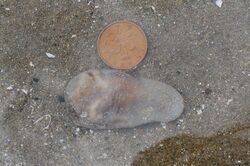Biology:Ascidiella aspersa
| Ascidiella aspersa | |
|---|---|

| |
| Ascidiella aspersa habitus | |
| Scientific classification | |
| Kingdom: | |
| Phylum: | |
| Subphylum: | |
| Class: | |
| Order: | |
| Suborder: | |
| Family: | |
| Genus: | |
| Species: | A. aspersa
|
| Binomial name | |
| Ascidiella aspersa (Müller, 1776)
| |
| Synonyms[1] | |
|
Species synonymy
| |
Ascidiella aspersa (European sea squirt) is a species of solitary sea squirts native to the northeastern Atlantic, from the Mediterranean Sea to Norway . They possess oval bodies up to 50 to 130 mm (2.0 to 5.1 in) in length. Their branchial (or oral) siphons are conical and positioned at the top of the body. They possess six to eight lobes. The atrial siphons are located at the upper third of the side of the body and possess six lobes. The body is covered by a firm transparent test that is greyish to brown in color. The test often snag detritus that remain loosely attached to the animal. When expanded, at most 40 tentacles can be observed on the inside surface of the branchial wall. Both the openings of the branchial and atrial siphons possess lighter colored ridges on their rims. They may also be frilled at times. A. aspersa are attached to the substrates by the left side of their bodies. They can be found in dense groups of unfused individuals on hard surfaces like rocks. at depths of up to 90 m (300 ft).[2][3][4][5]
A. aspersa closely resemble Ciona intestinalis, but can be distinguished by their lack of yellow markings around their siphons.[2]
References
- ↑ K. Sanamyan & C. Monniot (2011). "Ascidiella aspersa (Müller, 1776)". Ascidiacea World Database. World Register of Marine Species. http://www.marinespecies.org/aphia.php?p=taxdetails&id=103718.
- ↑ 2.0 2.1 "Ascidiella aspersa (O F Müller, 1776)". Encyclopedia of Marine Life of Britain and Ireland. 2010. http://www.habitas.org.uk/marinelife/species.asp?item=ZD1410. Retrieved February 6, 2012.
- ↑ Lisa Curtis (2005). "A sea squirt - Ascidiella aspersa". Marine Life Information Network (MarLIN). http://www.marlin.ac.uk/speciesinformation.php?speciesID=2627. Retrieved February 6, 2012.
- ↑ NIMPIS (2012). "Ascidiella aspersa (solitary ascidian)". National Introduced Marine Pest Information System. http://adl.brs.gov.au/marinepests/index.cfm?fa=main.spDetailsDB&sp=6000005711. Retrieved February 6, 2012.
- ↑ "Ascidiella aspersa". Macrobenthos of the North Sea - Tunicata. Maine Species Identification Portal. 2012. http://species-identification.org/species.php?species_group=tunicata&id=17. Retrieved February 6, 2012.
Wikidata ☰ Q11841378 entry

